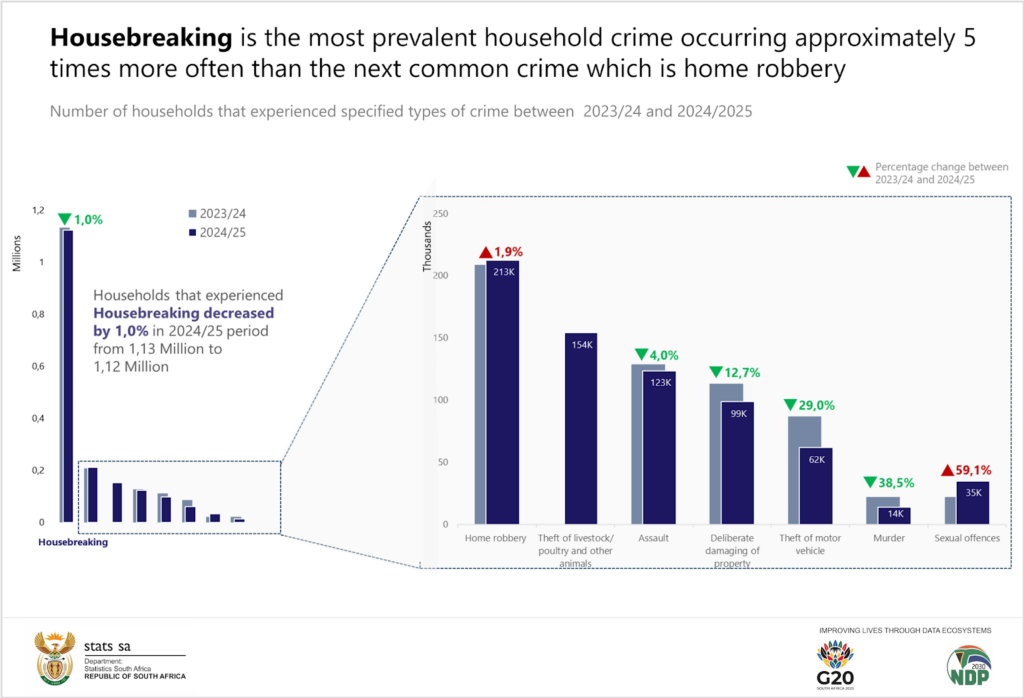Warning to South African homeowners with electric fences
Criminals in South Africa are continually adapting their methods to bypass home security systems, including electric fences.
Despite small declines in reported burglary and robbery cases, the number of break-ins recorded in South Africa is excessively high.
This makes regular security maintenance and awareness increasingly important for homeowners.
According to the latest South African Police Service (SAPS) crime statistics, more than 36,000 burglaries at residential premises and over 12,000 common robberies were recorded in the first quarter of 2025 alone.
This translates to approximately 400 burglaries per day. While the year-on-year decrease appears to provide a slight improvement on paper, South Africans’ sense of safety remains low, and many crimes go unreported.
Statistics South Africa noted that theft of personal property is the most common crime affecting individuals. However, approximately 70% of these incidents are not reported to the police.
Stats SA added that crime continues to impact daily life across the country, affecting people in both urban and rural areas, regardless of income level.
The Governance, Public Safety, and Justice Survey provides a more comprehensive picture when examining both reported and unreported crimes.
It showed that burglary has consistently been the most common crime affecting households. During 2024/25, an estimated 1.5 million housebreaking incidents occurred, affecting nearly 6% of households nationally.
Despite this, only 43% of these incidents were reported to the police. This means that more than half of break-ins never reach official crime statistics.
Electric fencing, once considered a strong deterrent, is now being challenged by increasingly sophisticated tampering techniques.
According to Gido Group manager Douglas Deerans, criminals have become adept at identifying weak points and manipulating fence systems to avoid detection.
He told MyBroadband that criminals are continually devising new methods to circumvent electric fences in South Africa.

Criminals target quick-to-grab items
He explained that one of the most common tactics involves using a V-shaped stick or plastic conduit to lift a group of wires away from the others, allowing someone to slip through without touching live conductors.
Another method is to place insulating sleeves over the wires, thereby preventing electrical contact.
Criminals may also cut multiple points of the fence simultaneously or install a makeshift bypass so that the electrical energiser does not detect a break in continuity.
Because many energisers are designed only to trigger alarms when they detect a single obvious disruption, coordinated cuts can slip past the system unnoticed.
In other cases, criminals simply break fence insulators or strike support brackets so that wires sag, creating a gap to move through.
Deerans noted that criminals often test fences before attempting entry. “If there is no click or response, they’ll push on,” he said.
Gate areas are another frequent weak spot, especially if the gate contact points are worn or incorrectly installed, which can break the electrical circuit and leave the fence effectively inactive.
To reduce these risks, Deerans advises homeowners to prioritise proper electric fence installation and insist on series wiring, which ensures that any break triggers an alarm.
Parallel wiring, he warns, can allow criminals to disable one section without being noticed. He also recommends installing robust gate contacts that maintain both live and earth continuity, and ensuring these are weather-rated and properly aligned.
Anti-lift brackets, anti-creep loops at wall corners, and frequent inspections of insulators and earthing points also help prevent tampering. “Good earthing and energiser placement are vital for both safety and reliability,” he said.
Importantly, an electric fence should not be relied on in isolation. Deerans emphasised that fences must form part of a layered security system, supported by alarms, cameras, lighting, and rapid response capability.
“Regular maintenance and proper monitoring remain the most effective deterrents against fence tampering,” he said.
Fidelity ADT’s Charnel Hattingh warned that criminals are increasingly focused on quick-to-grab items like laptops, tablets, phones, and other electronics, and often rely on speed and opportunity.
“Criminals are becoming more brazen and using different tactics to lure residents out of their homes,” she said.
She urged homeowners to remain alert, arm their alarms whenever leaving home, and ensure their perimeter security is working.
“If your perimeter is not secure, criminals are taking advantage. The suspects are quick, getting in and out within minutes.”



